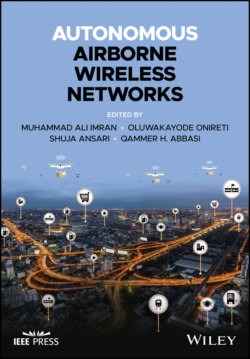Читать книгу Autonomous Airborne Wireless Networks - Группа авторов - Страница 2
Table of Contents
Оглавление1 Cover
7 2 Channel Model for Airborne Networks 2.1 Introduction 2.2 UAV Classification 2.3 UAV‐Enabled Wireless Communication 2.4 Channel Modeling in UAV Communications 2.5 Key Research Challenges of UAV‐Enabled Wireless Network 2.6 Conclusion Bibliography
8 3 Ultra‐wideband Channel Measurements and Modeling for Unmanned Aerial Vehicle‐to‐Wearables (UAV2W) Systems 3.1 Introduction 3.2 Measurement Settings 3.3 UWB‐UAV2W Radio Channel Characterization 3.4 Statistical Analysis 3.5 Conclusion Bibliography Notes
9 4 A Cooperative Multiagent Approach for Optimal Drone Deployment Using Reinforcement Learning 4.1 Introduction 4.2 System Model 4.3 Reinforcement Learning Solution 4.4 Representative Simulation Results 4.5 Conclusions and Future Work Acknowledgments Bibliography
10 5 SWIPT‐PS Enabled Cache‐Aided Self‐Energized UAV for Cooperative Communication 5.1 Introduction 5.2 System Model 5.3 Optimization Problem Formulation 5.4 Numerical Simulation Results 5.5 Conclusion Acknowledgments Appendix 5.A Proof of Optimal Solutions Obtained in (P1) Bibliography Notes
11 6 Performance of mmWave UAV‐Assisted 5G Hybrid Heterogeneous Networks 6.1 The Significance of UAV Deployment 6.2 Contribution 6.3 The Potential of mmWave and THz Communication 6.4 Challenges and Applications 6.5 Fronthaul Connectivity using UAVs 6.6 Communication Model 6.7 Association of SCBs with UAVs 6.8 Results and Discussions 6.9 Conclusion Bibliography Notes
12 7 UAV‐Enabled Cooperative Jamming for Physical Layer Security in Cognitive Radio Network 7.1 Introduction 7.2 System Model 7.3 Proposed Algorithm 7.4 Numerical Results 7.5 Conclusion Bibliography
13 8 IRS‐Assisted Localization for Airborne Mobile Networks 8.1 Introduction 8.2 Intelligent Reflecting Surfaces in Airborne Networks 8.3 Localization Using IRS 8.4 Research Challenges 8.5 Summary and Conclusion Bibliography
14 9 Performance Analysis of UAV‐Enabled Disaster Recovery Networks 9.1 Introduction 9.2 UAV Networks 9.3 Benefits of UAV Networks 9.4 Design Consideration of UAV Networks 9.5 New Technology and Infrastructure Trends 9.6 Research Trends 9.7 Future Insights 9.8 Conclusion Bibliography
15 10 Network‐Assisted Unmanned Aerial Vehicle Communication for Smart Monitoring of Lockdown 10.1 Introduction 10.2 UAVs as Aerial Base Stations 10.3 UAV as Relays for Terrestrial Communication 10.4 Conclusion Bibliography Note
16 11 Unmanned Aerial Vehicles for Agriculture: an Overview of IoT‐Based Scenarios 11.1 Introduction 11.2 The Perspective of Research Projects 11.3 IoT Scenarios in Agriculture 11.4 Wireless Communication Protocols 11.5 Multi‐access Edge Computing and 5G Networks 11.6 Conclusion Bibliography Notes
17 12 Airborne Systems and Underwater Monitoring 12.1 Introduction 12.2 Automated Image Labeling 12.3 Water/Land Visual Differentiation 12.4 Offline Bathymetric Mapping 12.5 Online Bathymetric Mapping 12.6 Conclusion and Future Work Bibliography
18 13 Demystifying Futuristic Satellite Networks: Requirements, Security Threats, and Issues 13.1 Introduction 13.2 Inter‐Satellite and Deep Space Network 13.3 Security Requirements and Challenges in ISDSN 13.4 Conclusion Bibliography Notes
19 14 Conclusion 14.1 Future Hot Topics 14.2 Concluding Remarks
20 Index
